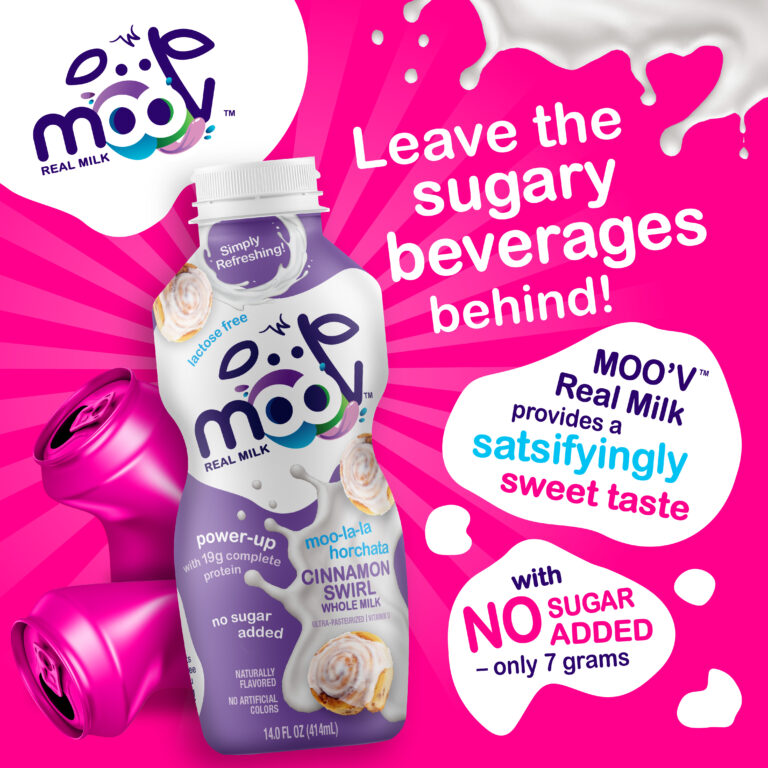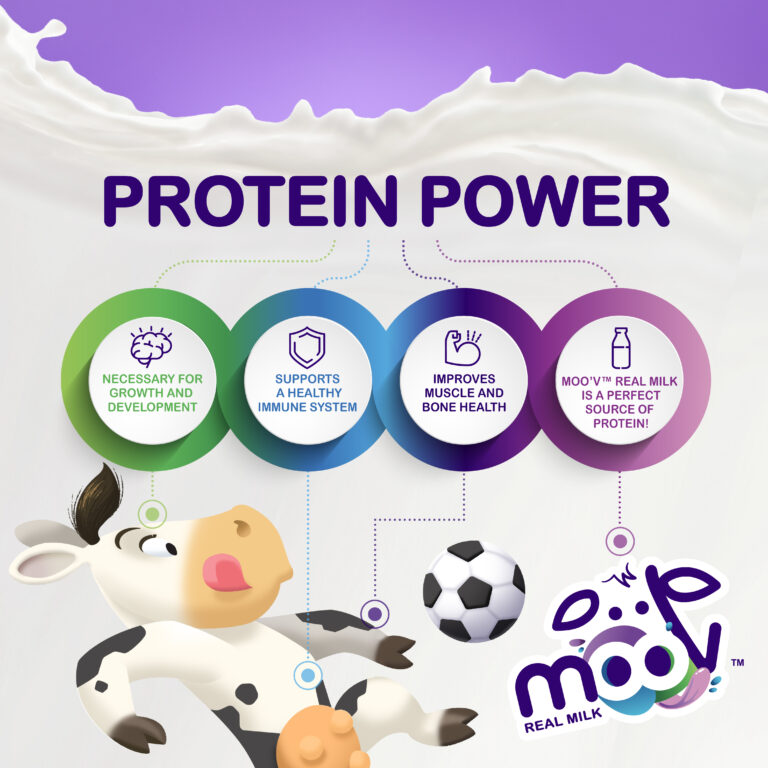TALES FROM THE
daRI® FARM

REDUCE THE SWEET AND STILL ENJOY A TREAT
By Leslie Bonci
When thinking about healthier eating, we don’t typically think of sweets. Sugar has gotten such a bad reputation, but it is important to set the record straight about what and how much sugar is okay to have in our glass, bowl, or plate.
First, let’s distinguish between natural sugars and added sugars. Natural sugars are those that naturally occur in foods. Fruits and vegetables contain sugar in the form of fructose, glucose, and sucrose. Dairy foods such as milk contain lactose, and grains contain maltose. When you think about all these foods, they are very high in nutritional value and health benefits…and contain natural sugars.
The type of sugar we are most concerned about are the sugars that get added to foods and beverages during processing and packaging. You can tell if they have been added by looking at the ingredient label for brown sugar, corn sweetener, corn syrup or high fructose corn syrup, honey, dextrose, malt sugar, invert sugar, molasses, or raw sugar. Too much added sugar may create health concerns such as increased risk for dental cavities, increased weight, elevated cholesterol and triglyceride levels and lower HDL (good cholesterol), and an increased risk for the development of type 2 diabetes.
HOW MUCH SUGAR IS TOO MUCH?
It is recommended that added sugars are limited to about 25 grams of 6 teaspoons of sugar a day for children. That means you want to look at the nutrition facts panel to see the amount of added sugar per serving as well as the ingredients list that will show you sources of sugar in the product.
HOW CAN YOU DECREASE THE SUGAR IN THE DRINKS AND FOODS YOUR KIDS CHOOSE?
- Look for foods and beverages with no added sugars…Like MOO’V™ Real Milk. It delivers a deliciously sweet taste with no added sugar. The sugar in MOO’V™ is 7g of natural sugar per 14 fluid ounces.
- Use smaller glasses for juice.
- Serve more fruit as snacks instead of cookies.
- When baking, try to reduce the amount of sugar in recipes.
- Bake smaller-sized cookies, cut brownies into smaller squares, or use mini muffin tins and mini cupcakes instead of large ones.
- Scoop Ice cream in a kiddie cup or cone for portion-perfect size.
- Limit the amount of syrup, honey, jelly being used.
- Play up the other senses – sour, salty, bitter and umami.
BOTTOM LINE
There is no reason to give up sugar altogether but try to stick to the natural sugars to help your kids health be its best.
Leslie Bonci, MPH, RDN, CSSD, LDN, is the Dietary & Nutrition Strategic Advisor at Dari® and MOO’V™ milk. With over two decades of experience, she is an expert in nutrition with many of Leslie’s blog posts center around active eating and fueling for sport. She is the Head Nutritionist for the Kansas City Chiefs and has been a consulting sports dietitian in the NFL, MLB, and NHL, and worked with Olympic athletes. Bonci has co-authored three books with an active eating focus, is a blogger for US News Eat + Run, and is a sought-after expert for television, radio, print and online media, Bonci speaks regularly on topics including “sciensationalism,” “fuels of engagement” and “communication with conviction” to help influencers and consumers debunk the junk and separate fact from fallacy.

BE IN THE KNOW WITH YOUR PRO
By Leslie Bonci
For kids to grow well…and stay well, they need to get the Pro-tein on the plate. Protein is an essential macronutrient (macro) necessary for growth and development, muscle health, bone health and to support a healthy immune system. When you don’t have enough protein, you can feel tired, have trouble concentrating, experience delayed growth, longer wound healing time and get sick more often.
HOW MUCH PROTEIN DO KIDS NEED TO SUPPORT THEIR GROWING BODY?
AGE PROTEIN NEEDS (grams/day)
4-8 19
9-13 34
For kids that are active or athletes, the amount of protein needed could even be higher.
The goal is to eat enough protein but make sure that you balance the diet our with Carbs and healthy fats too. And that is the reason why I love MOO’V™ Real Milk! It deliciously delivers on protein, carbs, vitamins and minerals, and it counts as a fluid. Milk is a high quality protein meaning it supplies all the essential amino acids as well as Vitamins A, D, E, niacin, riboflavin, pantothenic acid, Vitamin B12 and the minerals calcium, phosphorus, potassium, iodine, selenium and zinc.
HOW TO CONSUME PROTEIN OVER THE DAY
When we talk about optimizing protein intake, that means protein containing foods as part of every meal, not just dinner. MOO’V™ Real Milk is a great grab-and-go for breakfast, enjoyed with a piece of fruit or granola bar for a mid-day snack, blended with fruit in a smoothie, or poured in a bowl with cold or hot cereal. MOO’V™ Real Milk ups the protein game at lunch along with PBJ and is a great choice for kids with picky palates or who do not like the texture of other protein foods. A serving of MOO’V™ meets 50% of the day’s protein requirement for 9-13 year olds in a portable, palatable and no effort way.
So, to help your kids grow well and stay well, join the MOO’V-ment. Helping kids score with their pour and ensuring that you are optimizing their protein intake every day.
Leslie Bonci, MPH, RDN, CSSD, LDN, is the Dietary & Nutrition Strategic Advisor at Dari® and MOO’V™ milk. With over two decades of experience, she is an expert in nutrition with many of Leslie’s blog posts center around active eating and fueling for sport. She is the Head Nutritionist for the Kansas City Chiefs and has been a consulting sports dietitian in the NFL, MLB, and NHL, and worked with Olympic athletes. Bonci has co-authored three books with an active eating focus, is a blogger for US News Eat + Run, and is a sought-after expert for television, radio, print and online media, Bonci speaks regularly on topics including “sciensationalism,” “fuels of engagement” and “communication with conviction” to help influencers and consumers debunk the junk and separate fact from fallacy.

EAT RIGHT TO PROTECT THOSE PEARLY WHITES
By Leslie Bonci
Many of us have heard that there are foods that protect our bones, but you may not know that there are foods and beverages that play an important role in keeping our teeth and gums healthy too.
TEETH-FRIENDLY FOODS
Foods that are high in calcium help to make teeth strong by protecting tooth enamel. Here are some foods that are high in calcium:
- Dairy milk
- Yogurt
- Cheese
- Canned salmon or other canned fish (with bones)
- Almonds
- Some dark green leafy vegetables
Foods containing Phosphorus also help to make our teeth strong by protecting the tooth enamel. Foods that are high in phosphorus include:
- Eggs
- Fish
- Meat
- Poultry
- Dairy foods
- Beans such as chickpeas, black beans, kidney beans, pinto beans, soy beans
- Nuts
Vitamin C containing foods help to keep gums healthy. Look for the following foods with Vitamin C:
- Citrus fruits
- Tomatoes
- Peppers
- Kiwi
- Broccoli
- Spinach
- Potatoes
Drinking enough liquid helps to stimulate the flow of saliva. Give the drinks a try:
- Water
- Milk
- Fruit
- Vegetables
EATING HABITS THAT PROMOTE GOOD ORAL HEALTH
Eating constantly throughout the day, especially snacks that have a lot of carbohydrates such as chips, pretzels, cookies, and candy can cause tooth decay. This is why it is important to make the most of meals to minimize the hunger between meals and the need for in-between-meal snacking. MOO’V™ is a great option as it provides protein to help kids feel fuller longer between meals, and because it is whole milk, it is also a great source of calcium and phosphorus. Some great ideas for smart snacking include:
- A banana with peanut butter
- Veggies with bean dip
- A smoothie made with milk
- Yogurt dip and cut up fruit
- Cheese and crackers
So, what about sugar?
Let’s face it, foods that are sweet taste great. But too many sweets are not great for the teeth. When we talk about sugar and teeth health, not all sugars are created equal. Dairy, fruit, vegetables and grains all contain sugar but are high in nutritional value. On the other hand, soda, fruit drinks, desserts, candy and even savory snacks can increase the risk of tooth decay and should be limited. When they are eaten, it should be as part of a meal and not by themselves.
When it comes to your kid’s teeth and gum health, help them choose wisely from in the refrigerator and on the pantry shelf. Grabbing MOO’V™ is a great way to provide kids a delicious flavor to savor while also providing the fluid, protein, and minerals that are important for bones and teeth.
Leslie Bonci, MPH, RDN, CSSD, LDN, is the Dietary & Nutrition Strategic Advisor at Dari® and MOO’V™ milk. With over two decades of experience, she is an expert in nutrition with many of Leslie’s blog posts center around active eating and fueling for sport. She is the Head Nutritionist for the Kansas City Chiefs and has been a consulting sports dietitian in the NFL, MLB, and NHL, and worked with Olympic athletes. Bonci has co-authored three books with an active eating focus, is a blogger for US News Eat + Run, and is a sought-after expert for television, radio, print and online media, Bonci speaks regularly on topics including “sciensationalism,” “fuels of engagement” and “communication with conviction” to help influencers and consumers debunk the junk and separate fact from fallacy.